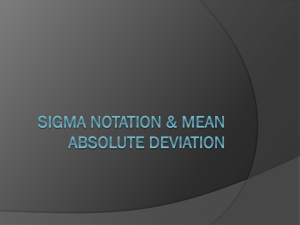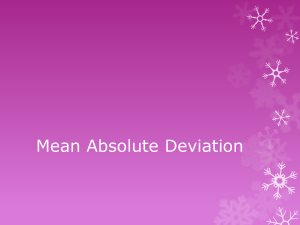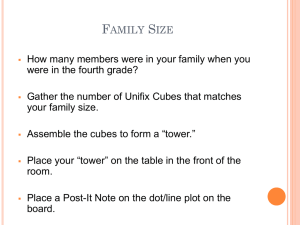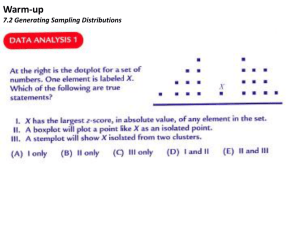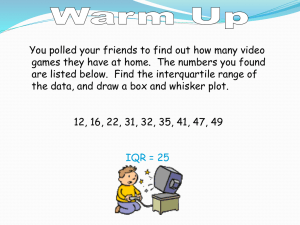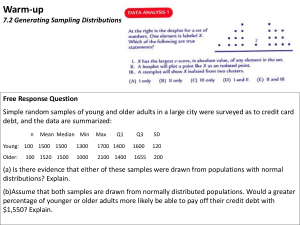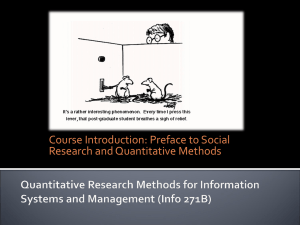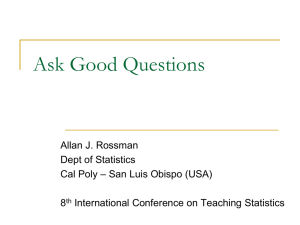Teaching the Common Core Statistics Standards for Grades 6
advertisement
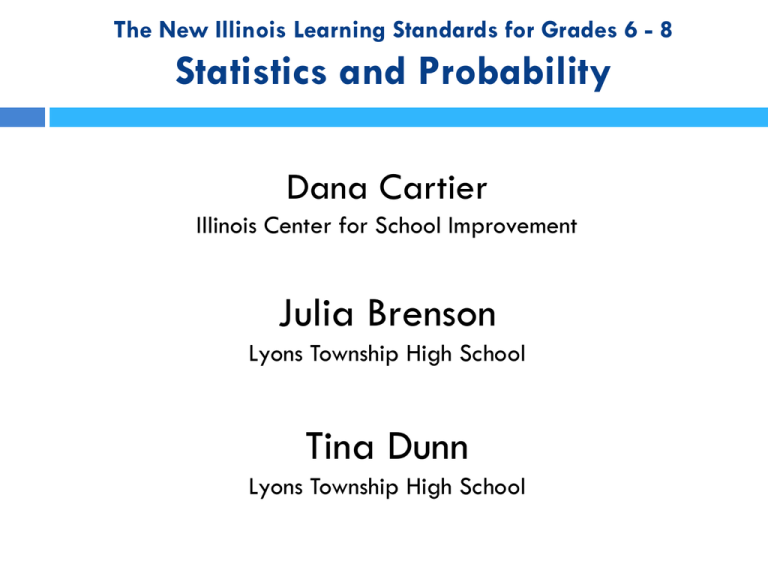
The New Illinois Learning Standards for Grades 6 - 8 Statistics and Probability Dana Cartier Illinois Center for School Improvement Julia Brenson Lyons Township High School Tina Dunn Lyons Township High School The New Illinois Learning Standards Agenda Resources Available Through ISBE Sixth Grade – Shape, Center, Spread Seventh Grade – Random Sampling for Inference and Simulation for Probability Eighth Grade – Bivariate Data The New Illinois Learning Standards ILStats http://ilstats.weebly.com/ All materials from this session are available at this website. This website is currently under construction, but please keep checking back for more information about the Statistics Standards. The New Illinois Learning Standards Sixth Grade Statistics Standards for 6th Grade 6th Grade Standard Focus PBA EOY 6.SP.A.1 Additional X No 6.SP.A.2 Additional X No 6.SP.A.3 Additional X No 6.SP.B.4 Additional X Yes 6.SP.B.5 Additional X Yes Calculator Statistics Standards for th 6 Grade 6.SP.A.2 Understand that a set of data collected to answer a statistical question has a distribution which can be described by its center, spread, and overall shape. 6.SP.A.3 Recognize that a measure of center for a numerical data set summarizes all of its values with a single number, while a measure of variation describes how its values vary with a single number. 6.SP.B.4 Display numerical data in plots on a number line, including dot plots, histograms, and box plots. Statistics Standards for th 6 Grade 6.SP.B.5 Summarize numerical data sets in relation to their context, such as by: 6.SP.B.5a Reporting the number of observations. 6.SP.B.5b Describing the nature of the attribute under investigation, including how it was measured and its units of measurement. 6.SP.B.5c Giving quantitative measures of center (median and/or mean) and variability (interquartile range and/or mean absolute deviation), as well as describing any overall pattern and any striking deviations from the overall pattern with reference to the context in which the data were gathered. 6.SP.B.5d Relating the choice of measures of center and variability to the shape of the data distribution and the context in which the data were gathered Statistics Standards for 6th Grade Types of Graphs Gaps Categories No Gaps Statistics Standards for 6th Grade Shape, Center and Spread BIG IDEAS: When describing distributions, we talk about Shape, Center, and Spread in the context of the data. Try to use real life data rather than made up data sets whenever possible. Statistics Standards for 6th Grade Shape of the Distribution Dot Plot Shapes of Distributions 0 2 4 6 8 10 12 14 16 18 Approxim ately_Sym m etrical 20 22 Approximately Symmetrical Dot Plot Shapes of Distributions Dot Plot Shapes of Distributions unusually large value 0 2 4 6 8 10 12 14 Skew ed_Right 16 18 20 22 Skewed 0 2 4 6 8 10 12 14 Skew ed_Left 16 18 20 22 Statistics Standards for Algebra I/Math I Shape of the Distribution What would the shape be for the distribution of salaries of the 2013 Chicago Cubs? The distribution of salaries for the 2013 Chicago Cubs is skewed. Most players made less than $2 million. There are two players that made an exceptionally large salaries. (Alfonso Soriano made $19 million and Edwin Jackson made $13 million.) Statistics Standards for 6th Grade Measures of Center Mean = 𝑠𝑢𝑚 𝑜𝑓 𝑜𝑏𝑠𝑒𝑟𝑣𝑎𝑡𝑖𝑜𝑛𝑠 𝑖𝑛 𝑑𝑎𝑡𝑎 𝑠𝑒𝑡 𝑛𝑢𝑚𝑏𝑒𝑟 𝑜𝑓 𝑜𝑏𝑠𝑒𝑟𝑣𝑎𝑡𝑖𝑜𝑛 𝑖𝑛 𝑑𝑎𝑡𝑎 𝑠𝑒𝑡 Median = the center most value when observations in the data set are ordered BIG IDEA: The median is a better measure of center when the data is skewed. Statistics Standards for Algebra I/Math I Measures of Central Tendency What was a typical salary for a baseball player on the 2013 Chicago Cub Team? Median = $1,550,000.00 Mean = $3,485,024.20 What is the better measure of center for this data? Why? 6th Grade & Algebra I / Math I Measures of Center Demonstration: Comparing the Mean and Median NCTM Illuminations Mean and Median Applet http://illuminations.nctm.org/Activity.aspx?id=3576 6th Grade & Algebra I / Math I Measures of Center Comparing the Mean and Median Statistics Standards for 6th Grade Measures of Center The Mean as Fair Share Dave, Sandy, Javier, and Maria have 12 cookies. How many cookies will each student have if each student receives a fair share? 3 3 12 3 3 Statistics Standards for 6th Grade Measures of Center The Mean as Fair Share What would each student’s fair share be if there are: 14 cookies? 9 cookies? 7 cookies? ? ? ? ? Statistics Standards for 6th Grade Measures of Center From the PARCC Grade 6 EOY Evidence Table Evidence Statement Key 6.SP.3 Rate the following statement as True/False/Not Enough Information. “The average height of trees in Watson Park is 65 feet. Are there any trees in Watson Park taller than 65 feet?” Statistics Standards for 6th Grade Measures of Spread Range = maximum value – minimum value Interquartile Range = Quartile3 – Quartile1 Interquartile Range (iqr) is the spread of the middle 50% of the data. Mean Absolute Deviation (MAD) = sum of the distances of each data value from the mean divided by the total number of observations. Big Idea: The mean absolute deviation (MAD) is the average distance (deviation) of data values from the mean. Statistics Standards for 6th Grade Measures of Spread The Mean as a Balance Point (An Introduction to MAD) From Engage NY Grade 6 Module 6 Lesson 7 Sabina wants to know how long it takes students to get to school. She asks two students how long it takes them to get to school. It takes one student 1 minute and the other student 11 minutes. She thinks the mean is the balance point. What do you think? http://www.engageny.org/sites/default/files/resource/attachments/math-g6-m6-teacher-materials.pdf Statistics Standards for 6th Grade Measures of Spread Introducing Deviations A deviation is the distance of a piece of data from the mean. A value that is below the mean has a negative deviation. A value above the mean has a positive deviation. The deviation of 1 to the mean is 1 – 6 = - 5 The deviation of 11 to the mean is 11 – 6 = 5 Questions: 1) What is the deviation from the mean for each of the pennies? 2) What is the sum of these two deviations? Statistics Standards for 6th Grade Measures of Spread Introducing Deviations Sabrina wants to know what happens if there are more than two data points. Suppose there are three students. One student lives 2 minutes from school, and another student lives 9 minutes from school. If the mean time for all three students is 6 minutes, she wonders how long it takes the third student to get to school. She tapes pennies at 2 and 9. -4 +3 +1 Questions: 1) Where should the third penny be placed to balance the ruler? 2) How can we use deviations to check this answer? Statistics Standards for 6th Grade Measures of Spread Introducing Mean Absolute Deviation (MAD) Activity: School Night Sleep How many hours of sleep do sixth graders get on a school night? Let’s make some predictions: 1) Typically, how many hours of sleep do you think a sixth grader gets? 2) How much will the number of hours of sleep vary if we asked a group of ten sixth graders? 3) What do you predict will be the fewest hours? 4) What do you predict will be the most hours? Statistics Standards for 6th Grade Measures of Spread On Monday morning, Carlos asked ten of his sixth grade classmates how many hours of sleep they usually get on school nights. He then created a dot plot of their answers. Questions: 1) Looking at the dot plot above, typically how much sleep did the ten sixth graders get on a school night? 2) How much did the amount of sleep vary? 3) What is the shape of this distribution? Statistics Standards for 6th Grade Measures of Spread Let’s look at another method of measuring the spread of the data. Mean Absolute Deviation (MAD) The mean absolute deviation (MAD) is the average distance of the data from the mean. We find MAD by doing these steps: 1) Calculate the mean. 2) Find the deviation for each data value. 3) Take the absolute value of each deviation. 4) Find the average of these absolute deviations (distances). Statistics Standards for 6th Grade Measures of Spread Calculating Mean Absolute Deviation (MAD) Sleep Hours Absolute Deviation Student on School Night Deviation Hours - Mean (Hours) |Hours - Mean| Rachel Gerty Steve Juan Michael Josie Philip Sergio Catherine Grace Total 10 9 11 9 8 6.5 10 8 8 8 87.5 10 – 8.75 = 1.25 9 – 8.75 = 0.25 2.25 0.25 -0.75 -2.25 1.25 -0.75 -0.75 -0.75 0.00 1.25 0.25 2.25 0.25 0.75 2.25 1.25 0.75 0.75 0.75 10.5 𝑇𝑜𝑡𝑎𝑙 ℎ𝑜𝑢𝑟𝑠 Mean = 𝑛𝑢𝑚𝑏𝑒𝑟 𝑜𝑓 𝑠𝑡𝑢𝑑𝑒𝑛𝑡𝑠 = 87.5 10 = 8.75 hours MAD = 𝑇𝑜𝑡𝑎𝑙 𝐴𝑏𝑠𝑜𝑙𝑢𝑡𝑒 𝐷𝑒𝑣𝑖𝑎𝑡𝑖𝑜𝑛𝑠 𝑛𝑢𝑚𝑏𝑒𝑟 𝑜𝑓 𝑠𝑡𝑢𝑑𝑒𝑛𝑡𝑠 = 10.5 10 = 1.05 hours Statistics Standards for 6th Grade Measures of Spread Interpreting Mean Absolute Deviation (MAD) mean - MAD mean mean + MAD Mean = 8.75 hours MAD = 1.05 hours The number of hours of sleep on a school night for these ten sixth graders varies1.05 hours, on average, from the mean of 8.75 hours. Statistics Standards for 6th Grade Measures of Spread Mean Absolute Deviation (MAD) Ten sixth graders are asked to report the number of hours of sleep they typically get on a school night. Their hours of sleep are shown on the dot plot below. Questions: 1) What is the mean number of hours of sleep on a school night for these ten sixth graders? 2) What is the median? 3) How much variability is there amongst the ten sixth graders? 4) What is the value of MAD for this data? Statistics Standards for 6th Grade Shape, Center and Spread Activity What’s Your Age? Statistics Standards for 6th Grade Activities: Mean, Median, Mode, and Range (http://map.mathshell.org/materials/download.php?fileid=1360) Candy Bar (http://map.mathshell.org/materials/download.php?fileid=1178) How Long is 30 Seconds Statistics Education Web (STEW) (http://www.amstat.org/education/stew/pdfs/HowLongis30Seconds.pdf) The Mean as a Balance Point Engage NY Grade 6 Module 6 (http://www.engageny.org/sites/default/files/resource/attachments/math-g6-m6teacher-materials.pdf) What’s Your Age? The New Illinois Learning Standards Seventh Grade Statistics Standards for 7th Grade 7th Grade PBA* EOY Standard Focus 7.SP.A.1 Supporting X Yes 7.SP.A.2 Supporting X Yes 7.SP.B.3 Additional X Yes 7.SP.B.4 Additional X Yes 7.SP.C.5 Supporting X Yes 7.SP.C.6 Supporting X Yes 7.SP.C.7 Supporting X Yes 7.SP.C.8 Supporting X Yes Calculator * See Evidence Statement 7.D.3 Micro-models from the PARCC Evidence Table – Grade 7 PBA Statistics Standards for th 7 Grade 7.SP.A.1 Understand that statistics can be used to gain information about a population by examining a sample of the population; generalizations about a population from a sample are valid only if the sample is representative of that population. Understand that random sampling tends to produce representative samples and support valid inferences. 7.SP.A.2 Use data from a random sample to draw inferences about a population with an unknown characteristic of interest. Generate multiple samples (or simulated samples) of the same size to gauge the variation in estimates or predictions. For example, estimate the mean word length in a book by randomly sampling words from the book; predict the winner of a school election based on randomly sampled survey data. Gauge how far off the estimate or prediction might be. Statistics Standards for 7th Grade Random Sampling to Draw Inferences About a Population Activity: Gettysburg Address Part I Judgment Sample Part II Simple Random Sample Sampling Distribution Statistics Standards for 7th Grade Random Sampling to Draw Inferences About a Population Gettysburg Address Judgment Sample First ask students to take a quick look at the population of 268 words and select 5 words that they think form a representative sample of the length of words found in the Gettysburg Address. This is a judgment sample. Students record the five words and the number of letters in each word in the table provided. After calculating the mean of the sample, each student records his mean on the class dot plot on the chalkboard. Statistics Standards for 7th Grade Random Sampling to Draw Inferences About a Population How do we ensure that we select a sample that is representative of the population? We choose a method that eliminates the possibility that our own preferences, favoritism or biases impact who (or what) is selected. We want to give all individuals an equal chance to be chosen. We do not want the method of picking the sample to exclude certain individuals or favors others. One method that helps us to avoid biases is to select a simple random sample. If we want a sample to have n individuals, we use a method that will ensure that every possible sample from the population of size n has an equal chance of being selected. Statistics Standards for 7th Grade Random Sampling to Draw Inferences About a Population Which of the following would produce a simple random sample of size 6 from the population of all students in our classroom? A. Select the first 6 students that enter the classroom. B. Put every student’s name in a hat, mix and draw 6 names. C. The classroom has 6 tables with three students per table. Randomly select two tables. The students at these two tables are the sample. D. The classroom has 6 tables of students. Randomly select one student from each table. Statistics Standards for 7th Grade Random Sampling to Draw Inferences About a Population Back to Gettysburg Address Simple Random Sample Use a random number generator or a random digits table to select a simple random sample of size 5 from the population of 268 words. Statistics Standards for 7th Grade Random Sampling to Draw Inferences About a Population Random Digits Table Suppose, for example that we wanted a sample of size 5. There are 268 words. First select a row to use in the table. Select three digits at a time, letting 001 represent 1, 002 represents 2, and so on. Skip 000 and numbers that are greater than 268. Skip repeats. Our Sample: 32, 148, 238, 128, 104 Statistics Standards for 7th Grade Random Sampling to Draw Inferences About a Population Random Number Generator Random sample of 5 numbers representing the 5 words to be selected. The random number generator above is shared with permission from Beth Chance and Allan Rossman. This applet can be found at http://www.rossmanchance.com/applets/RandomGen/GenRandom01.htm Statistics Standards for 7th Grade Random Sampling to Draw Inferences About a Population Gettysburg Address Sampling Words – Permission to share this applet was given by Beth Chance and Allan Rossman. Number of Letters for all Population Words in the Population Mean Last random sample of size 5 that was selected. Sample Mean http://www.rossmanchance.com/applets/GettysburgSampleE/GettysburgSample.html Statistics Standards for 7th Grade Random Sampling to Draw Inferences About a Population Gettysburg Address 100 random samples of size 5 mean = 4.46 Statistics Standards for 7th Grade Random Sampling to Draw Inferences About a Population Gettysburg Address 500 random samples of size 5 Sampling Distribution mean = 4.313 Statistics Standards for th 7 Grade 7.SP.C.8 Find probabilities of compound events using organized lists, tables, tree diagrams, and simulation. 7.SP.C.8a Understand that, just as with simple events, the probability of a compound event is the fraction of outcomes in the sample space for which the compound event occurs. 7.SP.C.8b Represent sample spaces for compound events using methods such as organized lists, tables and tree diagrams. For an event described in everyday language (e.g., “rolling double sixes”), identify the outcomes in the sample space which compose the event. 7.SP.C.8c Design and use a simulation to generate frequencies for compound events. For example, use random digits as a simulation tool to approximate the answer to the question: If 40% of donors have type A blood, what is the probability that it will take at least 4 donors to find one with type A blood? Statistics Standards for 7th Grade Chance Processes and Probability Models Example: Tree Diagram Michael and Gita would like to have three children. What is the probability that all three children will be boys? Second Child First Child 0.5 0.5 B B Third Child Possible Outcomes 0.5 0.5 0.5 0.5 G 0.5 0.5 0.5 G 0.5 B 0.5 G 0.5 0.5 0.5 B G B G B G B G BBB (0.5)(0.5)(0.5) = 0.125 BBG BGB BGG GBB GBG GGB GGG Statistics Standards for 7th Grade Chance Processes and Probability Models Three Children Continued… Another way to look at this problem is to create a list of all possible outcomes (the sample space). (B, B, B) (B, B, G) (B, G, B) (B, G, G) (G, B, B) (G, B, G) (G, G, B) (G, G, G) This is a uniform distribution in which every outcome has an equal chance of occurring. There are 8 outcomes and each outcome has a 1/8 chance of occurring. We can now answer questions like: 1)What is the probability of the couple having 3 boys? 2)What is the probability of having one boy? Statistics Standards for 7th Grade Chance Processes and Probability Models Activity: Blood Type A If 40% of donors have type A blood, what is the probability that it will take at least 4 donors to find one with type A blood? Statistics Standards for 7th Grade Chance Processes and Probability Models Activity: Blood Type A Using a random digits table, let 1, 2, 3, 4 represent having type A blood. 0,5,6,7,8,9 represent not having type A blood. Select a row. Count how many digits it takes to reach a 1,2,3, or 4. Record this count with a tally mark in a table. Repeat many times to determine the long-run behavior. Statistics Standards for 7th Grade Chance Processes and Probability Models Row 14 15 16 17 18 12341 58842 89104 32161 43757 56847 12111 81316 07798 26081 41089 26072 21231 30021 63824 81678 36430 30263 11234 29902 84546 46319 92049 70043 11212 35106 52699 40588 88555 29892 34561 87744 12394 24581 90515 48430 12341 89832 59894 51397 64921 11287 Continue on to simulate the long run behavior or combine results with classmates. Statistics Standards for 7th Grade Chance Processes and Probability Models Blood Type A - Part II Tree Diagram Let A = the event that a donor has blood type A Let O = the event that a donor has some other blood type. OOOA (0.6)(0.6)(0.6)(0.4) = 0.0864 Statistics Standards for 7th Grade Activities: Gettysburg Address (A sampling activity) This activity is adapted from the Sampling Words activity by Beth Chance and Allan Rossman. Beth Chance and Allan Rossman have given permission for their Sampling Words applet to be shared with Illinois math teachers. (http://www.rossmanchance.com/applets/GettysburgSampleE/GettysburgSam ple.html ) Blood Type A The New Illinois Learning Standards Eighth Grade Statistics Standards for 8th Grade 8th Grade PBA* EOY Standard Focus 8.SP.A.1 Supporting X No 8.SP.A.2 Supporting X No 8.SP.A.3 Supporting X Yes 8.SP.A.4 Supporting X Yes Calculator * See Evidence Statement 8.D.2 (content from Grade 7 including 7.SP.B) and 8.D.3 (Micro-models) from the PARCC Evidence Table – Grade 8 PBA Statistics Standards for th 8 Grade 8.SP.A.1 Construct and interpret scatter plots for bivariate measurement data to investigate patterns of association between two quantities. Describe patterns such as clustering, outliers, positive or negative association, linear association, and nonlinear association. 8.SP.A.2 Know that straight lines are widely used to model relationships between two quantitative variables. For scatter plots that suggest a linear association, informally fit a straight line, and informally assess the model fit by judging the closeness of the data points to the line. 8.SP.A.3 Use the equation of a linear model to solve problems in the context of bivariate measurement data, interpreting the slope and intercept. For example, in a linear model for a biology experiment, interpret a slope of 1.5 cm/hr as meaning that an additional hour of sunlight each day is associated with an additional 1.5 cm in mature plant height. Statistics Standards for 8th Grade Investigate Patterns of Association in Bivariate Data What is bivariate data? bi - means two variate – means variable Bivariate data is data about two variables. If the two variables are numeric, we examine the relationship between the two variables using a scatterplot. If the two variables are categorical, we organize the data in a twoway frequency table and look for an association. Statistics Standards for 8th Grade Investigate Patterns of Association in Bivariate Data A look at sample activities for 8.SP.1-3 Oil Changes and Engine Repair Adapted from an NCTM Illuminations’ activity Bike Weights and Jump Heights NCTM Illuminations Animal Brains Illustrative Mathematics US Airports, Assessment Variation Illustrative Mathematics Patterns in Scatter Plots – Lesson 7 Classwork EngageNY Determining the Equation of a Line Fit to Data – Lesson 9 Problem Set EngageNY Statistics Standards for 8th Grade Investigate Patterns of Association in Bivariate Data Questions In what order would you use these activities in a unit? What questions did you particularly like? What questions are different than what we might typically ask students? Do you have suggestions for improvement of or additions to these activities? Statistics Standards for th 8 Grade 8.SP.A.4 Understand that patterns of association can also be seen in bivariate categorical data by displaying frequencies and relative frequencies in a two-way table. Construct and interpret a two-way table summarizing data on two categorical variables collected from the same subjects. Use relative frequencies calculated for rows or columns to describe possible association between the two variables. For example, collect data from students in your class on whether or not they have a curfew on school nights and whether or not they have assigned chores at home. Is there evidence that those who have a curfew also tend to have chores? Statistics Standards for 8th Grade Investigate Patterns of Association in Bivariate Data 8.SP.4 Summarize categorical data in two categories Big Ideas: Review the difference between numeric data and categorical data. Explain that frequency refers to the count of the data. Relative frequency is a proportion. Analyze relative frequencies and assess possible associations and trends in the data. Statistics Standards for 8th Grade Investigate Patterns of Association in Bivariate Data Association of two categorical variables There is an association between two categorical variables if the row (or column) conditional relative frequencies are different from row to row (or column to column) in the table. The greater the difference between the conditional relative frequencies, the stronger the association. Statistics Standards for 8th Grade Investigate Patterns of Association in Bivariate Data Activity: Music and Sports Adapted from Illustrative Mathematics (http://www.illustrativemathematics.org/illustrations/1098) Is there an association between whether a student plays a sport and whether he or she plays a musical instrument? To investigate this question, each student in your class should answer the following two questions: 1. Do you play a sport? (yes or no) 2. Do you play a musical instrument? (yes or no) Statistics Standards for 8th Grade Investigate Patterns of Association in Bivariate Data Music and Sports Summarize the class data in a two way frequency table. Musical Instrument No Musical Instruments Total Sport 6 No Sport 7 Total 13 8 14 3 10 11 24 Questions: 1. Of those students who play a sport, what proportion play a musical instrument? 2. Of those students who do not play a sport, what proportion play a musical instrument? 3. Based on the class data, do you think there is an association between playing a sport and playing an instrument? Statistics Standards for 8th Grade Activities 8-SP Oil Changes and Engine Repair Bike Weights and Jump Heights NCTM Illuminations 8.SP Animal Brains (http://www.illustrativemathematics.org/illustrations/1520) 8.SP US Airports, Assessment Variation (http://www.illustrativemathematics.org/illustrations/1370) Patterns in Scatter Plots – Lesson 7 Classwork (www.engageny.org) Monopoly - Determining the Equation of a Line Fit to Data – Lesson 9 Problem Set (www.engageny.org) Statistics Standards for 8th Grade More Activities 8-SP-4 Music and Sports Activity adapted from: (http://www.illustrativemathematics.org/illustrations/1370) Statistics Standards for Grades 6 - 8 Census at School (http://www.amstat.org/censusatschool/) Statistics Education Web (http://www.amstat.org/education/stew/) Acknowledgements and Resources Chance, B. & Rossman, A. (Preliminary Edition). Investigating Statistical Concepts, Application and Methods. Duxbury Press. Chance, B., et al. Rossman/Chance Applet Collection. Retrieved from http://www.rossmanchance.com/. Chicago Tribune. (2014, April). Chicago Bears. Retrieved from http://chicagosports.sportsdirectinc.com/football/nflteams.aspx?page=/data/nfl/teams/rosters/roster16.html Franklin, C., Kader, G., Mewborn, J. M., Peck, R., Perry, M. & Schaeffer, R. (2007) Guidelines for Assessment and Instruction in Statistics Education (GAISE) Report: A Pre-K12 Curriculum Framework. Alexandria, VA: American Statistical Association. McCallum, B., et al. (2011, December 26). Progressions for the Common Core State Standards in Mathematics (draft) 6-8 Statistics and Probability. Retrieved from http://commoncoretools.files.wordpress.com/2011/12/ccss_progression_sp_68_2011_12_26_b is.pdf. McCallum, B., et al. (2012, April 21). Progressions for the Common Core State Standards in Mathematics (draft) High School Statistics and Probability. Retrieved from http://commoncoretools.me/wpcontent/uploads/2012/06/ccss_progression_sp_hs_2012_04_21_bis.pdf. Acknowledgements and Resources Moore, D. & McCabe, P. (1989). Introduction to the Practice of Statistics. New York, NY: W. H. Freeman. Rossman, A. (2012). Interview With Roxy Peck. Journal of Statistics Education, 20(2). pp. 1 – 14. Retrieved from http://www.amstat.org/publications/jse/v20n2/rossmanint.pdf. Rossman, A., Chance, B., & Von Oehsen, J. (2002). Workshop Statistics Discovery With Data and the Graphing Calculator. New York: Key College Publishing. Scheaffer, R., Gnanadesikan, M., Watkins, A., & Witmer, J. (1996). Activity-Based Statistics. New York: Springer-Verlag. Online Resources Census at School. http://www.amstat.org/censusatschool/ Consortium for the Advancement of Undergraduate Statistics Education. http://causeweb.org/ Engage NY. http://www.engageny.org/mathematics Illustrative Mathematics. http://www.illustrativemathematics.org/ Inside Mathematics. http://www.insidemathematics.org Mathematics Assessment Project. http://map.mathshell.org/ Math Vision Project. http://www.mathematicsvisionproject.org/ NCSSM Statistics Institutes. http://courses.ncssm.edu/math/Stat_Inst/links_to_all_stats_institutes.htm NCTM Core Math Tools – Data Sets http://www.nctm.org/resources/content.aspx?id=32705 Online Resources PARCC Model Content Frameworks. http://www.parcconline.org/sites/parcc/files/PARCCMCFMathematicsNovemb er2012V3_FINAL.pdf PARCC Mathematics Evidence Tables. https://www.parcconline.org/assessmentblueprints-test-specs Smarter Balanced Assessment Consortium. http://www.smarterbalanced.org/ Statistics Education Web (STEW). http://www.amstat.org/education/STEW/ The Data and Story Library (DASL). http://lib.stat.cmu.edu/DASL/ The High School Flip Book Common Core State Standards for Mathematics. http://www.azed.gov/azcommoncore/files/2012/11/high-school-ccss-flipbook-usd-259-2012.pdf The New Illinois Learning Standards for Grades 6 - 8 Statistics and Probability Thank you for joining us! Dana Cartier Julia Brenson Tina Dunn dcartier@illinoiscsi.org jbrenson@lths.net tdunn@lths.net
